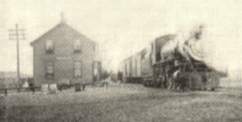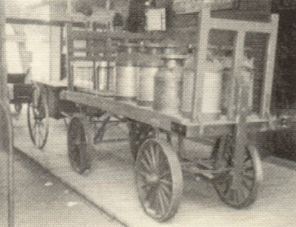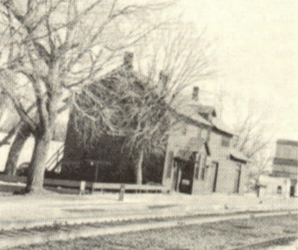MULLEN BURLINGTON RAILROAD AND DEPOT
by Claudia Tompkins
Entry T12 from the History of Hooker County Nebraska
with permission of the Hooker County Historical Society


"Working on the Railroad"

Laying of the 'Rails' to Mullen 1887.

Mullen Depot early 1900's.

Mullen Depot and Water Tank 1920's.

Cream to be shipped out to large Creamery in
eastern Nebraska.

Mullen Section House about 1965 - Has since been razed.

Mullen Depot 1971 just before it was torn down.

The last passenger train going west out of Mullen
#43 fall of 1969.
In 1880, plans started to take form for a
railroad to be built through Nebraska and
through the Sandhills. A market had to be
provided for the cattlemen. The railroad
reached Mullen in the fall of 1887. Prior to
the coming of the railroad there had been a
small store operated by a man named Tre-
fren. This was located southeast of where the
rodeo grounds are now. The railroad pur-
chased land for their switchyards, station,
etc., a mile east of the store and named the
siding Mullen after Charles D. Mullen of
Lincoln, Chief Clerk for D.E. Thompson,
Division Superintendent of the CB&Q. The
actual naming was done by T.E. Calvert,
General Superintendent for the railroad.
The Hooker County Tribune October of
1903 stated "The new B.M. Depot is fast
nearing completion. The painting gang ar-
rived a day or two sooner than expected, but
once the towering new structure of which
Mullen is proud, began to take on appearance
more noticeable, at this time, the office and
waiting room are nearly ready for occu-
pancy." November 1903 - "The new Depot
is now undergoing the plastering process."
The Train Schedule in 1903 was for No. 43
West 3:30 A.M. and 44, all points east 7:09
A.M. W.E. Sharp, Agent. In 1906 Train No.
41 West went through Mullen at 10:25 A.M.
and No. 42 East, went through at 7:50 P.M.,
the Agent R.E. Cazad.
A move was started in June 1919 to work
into the kindly graces of the Burlington
railway commission to the extent of having
them provide ways and means for stopping
trains No. 41 and 42 at Mullen, as they had
at most county seat towns, many of which
were less important from a business stand-
point than Mullen. Petitions were circulated
and sent to the railway regulators.
In April, 1920, traveling men out of Omaha
gave out the information that the Burlington
had decided to put on 2 extra passenger trains
again to run between Ravenna and Alliance,
commencing June 1st. Trains 43 and 44 were
to be made through trains which meant that
they would pass up Mullen the same as
though it was a blind siding and the new
trains 41 and 42 would be the only ones
operated for the accomodation of the public.
A quote from the Hooker County Tribune
June 4, 1920 - "The Burlington certainly
has put a bad kink in mail service from
Mullen as well as disgusting the traveling
public from and to this point. The first three
fast trains east missed grabbing the 1st class
mail which doubtless has resulted in much
inconvenience to important correspondence,
and for a few days they had balled up in such
a way that neither Postmaster Pickett, now
the `Bob-tail' mail, or the merchants knew
what to do with the parcels post and 2nd class
mail. We are now told that parcels post
packages for Omaha or other points east must
go to Alliance to catch the fast train. How-
ever, it is not expected that the present
unsatisfactory service will be long lived as
different towns have taken up the matter
with the postal department, also with the
company and state railway commission. The
present service is about as rotten as it could
be and most any kind of a change would
better things a little."
Mullen took another important step tow-
ard the goal of up-to-date little cities. After
much solicitation by the village board and
railroad company, in 1922, there was an
agreement to place a bell signal at the main
street crossing just west of the depot.
Shippers of livestock from Mullen Stock-
yards, were greatly pleased in October, 1927,
over the building of much additional yardage
by the Burlington. With the shipment of
several hundred head of cattle by the T.O.
Ranch, one week, the additional parking
space was plentiful.
A quote December 16, 1927 from the
county paper ". . Figures recently made
public by the Burlington Railroad to show
the number of carload shipments of cattle
made from stations between Alliance and
Seneca between the dates of July 1, and
November 15, 1927: Seneca, 116; Mullen, 476;
Hecla, 191 ; Whitman, 474; Hyannis, 512;
Ashby, 242; Bingham, 238; Ellsworth, 128;
Lakeside, 437; Antioch, 171; and Alliance,
389. The complete figures should leave no
doubt as to the wonderful production of meat
that goes annually from this section of the
vast plains country of West central Nebraska
into the food channels of the world's market."
Burlington surveyors surveyed a site east
of the cemetery for the removal of the
stockyards in 1929. Additional sidetrack was
built and other arrangements carried out for
the convenience of shippers from the Mullen
point. This was a jolly bit of news to the
ranchers and others concerned. From the
Mullen point, the shipping season of 1927 was
the heaviest in the history of this section,
which consisted of heavy incoming shipments
of merchandise during the year, and 49
carloads of automobiles. The freight receipts
at the depot for 1928 were close to $100,000
or averaged $10,000 a month, which was a fine
showing for a town the size of Mullen. Agent
McKinnie stated that the freight receipts of
Mullen exceeded those of the Broken Bow
station through the months of August, Sep-
tember, and October of 1928.
Telegrams sent through the telegraph lines
was an important means of communication
through the Mullen Depot. Some of the early
agents were: Claude Thurmands, Ray Sprad-
ling, Grover Davis, B.F. Neltten, J.L. McKin-
nie, Paul Ragsdale, Guy King and Emily
Carpenter King as a dispatcher; there were
others we have no record of.
After much `on' and `off' again about the
discontinuation of passenger trains 42 and 43
from Omaha to Billings, Montana, it was
finally finalized. Trains 44 and 41 had been
discontinued previously. Division Superin-
tendent E.L. Phillips of Alliance, Nebraska
claimed the Railroad had losses of $1,000,000
annually in their operation, as he informed
the public in 1968. He reported that in 1967
Mullen had 51 persons boarding westbound
#43 and 211 persons getting off. Eastbound
train #42 had 286 boarding and 61 getting off.
Mr. Phillips stated that wages and fringe
benefits of the crewmen were 4 times the
amount of ticket sales. Mail revenue had also
dropped since the Post Office Department
had gone to trucks and airplanes. He also
stated this was the last line in the state to
have mail clerks on the train. Mullen was left
without any transportation out of town, no
train service and no bus service which had
lasted only a short period of time. School
buses are used to transport students to
distant school activities and the Senior
Citizens have access to the Mini-Bus and
driver.
The Mullen Depot was a very early land-
mark with the big water supply tank near by.
In 1971 the depot was torn down, victim of
progress. The supply water tank that was
used for the steam engines to refill was also
taken down. The Section House was razed
even before the tank and Depot, about 1966
or so.
There have been freight train wrecks near
Mullen and within the city limits. February
1972, the Burlington-Northern freight train
derailed just west of the light plant - six cars
that were empty and one carried mail, and
other merchandise. Luckily there were no
injuries. In January 1976, 14 Burlington-
Northern coal cars, of an east bound freight,
overturned west of the village utility build-
ing. Some 300 tons of dumped coal was given
to Mullen School District for hauling it away.
One train hauling ammunition and cars of a
mineral substance near the siding of Weir,
west of Mullen, wrecked in the late 60's. The
scar along the tracks still remains as a result
of the mineral killing all vegetation. Another
wreck in the late 40's or early 50's was at the
Kelso siding, which upended and over-turned
many freight cars. The one in May of 1973
was so sickening, as a truck load of cattle was
struck by a freight train at the crossing in
Mullen. 51 head of cattle out of 89 were lost.
$10,000 damage to the truck and between
$30,000 and $40,000 to the train engine. The
truck driver received minor injuries & the
train crew escaped injury.
In 1978, the Burlington Railroad installed
new Cross Arms at the Mullen crossing, that
are designed to go down when a train is
moving near the crossing.
Those of us who have memories of riding
the passenger trains that passed through
Mullen, recall how we huddled near the pot
bellied stove in the center of the room of the
depot during the winter, waiting for the
lonely whistle in the distance, of the ap-
proaching train. Sometimes the train would
be late which would make us impatient. In
warmer weather we waited sitting on the long
wooden benches along the west wall, facing
the agent's office, with the sounds of the
telegraph signals coming through. When the
train arrived, the conductor would get off and
place a foot stool on the ground for passen-
gers to more easily get off or on the train.
This was a scene often repeated thousands
of times in early Nebraska. The local railroad
depot was one of the most important build-
ings in town. Without it, the town may not
have grown and prospered.
As early as the turn of the century, railroad
depots were built for the railroads conven-
ience only. Later towns were established at
the depot sites. From these Depots, many
Nebraska sons "shipped out" from their local
Depot during World War I, saying farewell to
family and friends. Later came World War II,
and "troop trains" were reborn, again
carrying our boys to camps and later, the
European or Asian theaters.
Passenger service ended in most of Nebras-
ka in 1971, when Amtrak began.
Our Mullen Depot is gone, only the memo-
ries of it remain. However, many long coal
trains of a mile in length and sometimes as
long as two miles, pass through our town as
well as many freight trains with cargo. These
trains roar by on the double tracks that were
built in the '70's.








